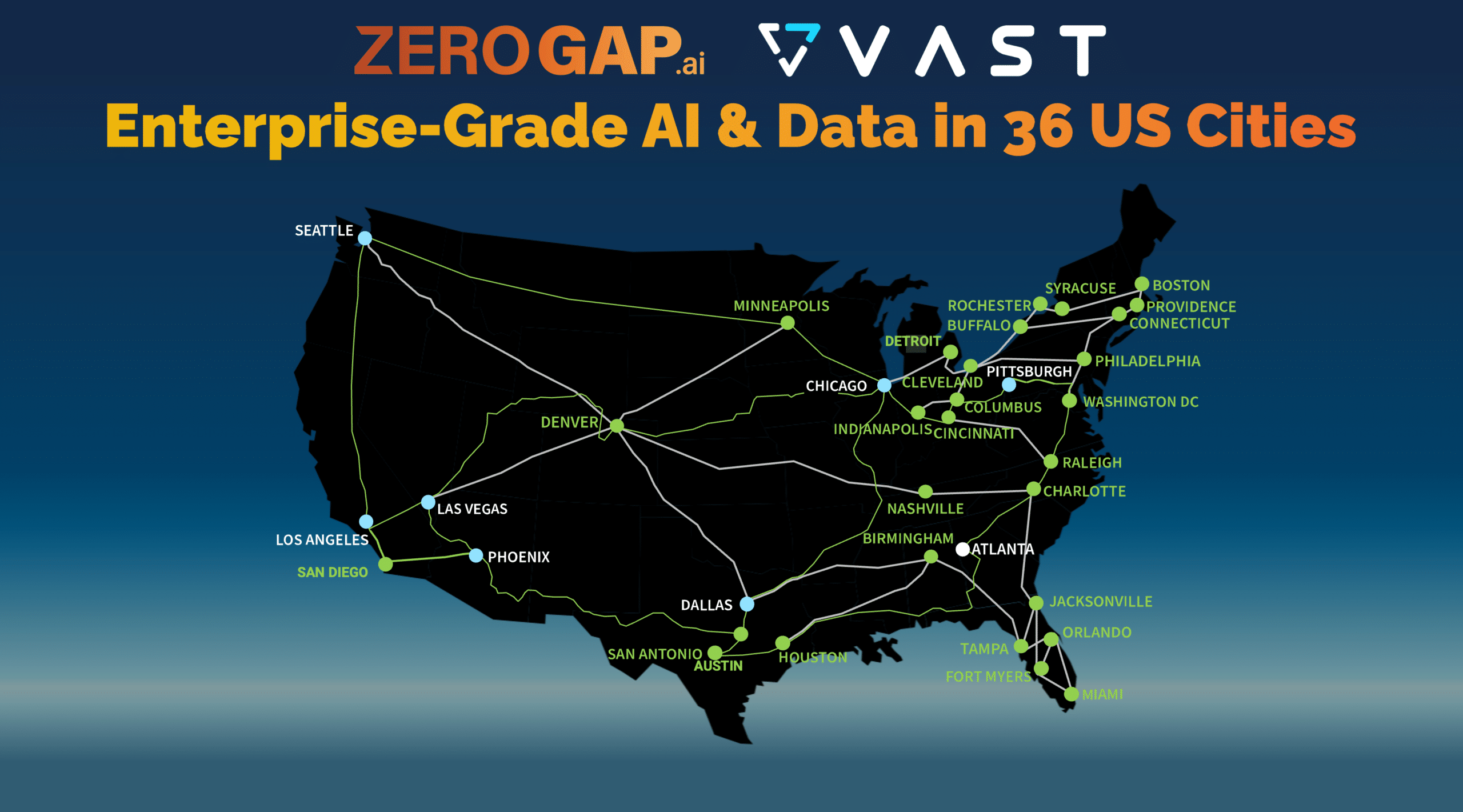Today, Vapor IO announced a collaboration with VAST Data. The purpose of this collaboration is to integrate the VAST Data platform into Vapor IO’s Zero Gap AI. Both companies recognize that the effectiveness of AI solutions is intrinsically tied to the quality and quantity of data. Data silos within organizations and the fragmented nature of datasets across geographies have historically limited the potential of AI.
We are working with VAST Data to build a global AI fabric, a distributed architecture that facilitates seamless data management and AI processing across different locations and data sources. It breaks down information silos, bridging the gap between on-premises data centers, cloud storage, and edge computing. The combined solution will make it possible for customers to marry their data across all geographies with the highest performance and most appropriate computational resources, optimized for local access.
The combined platform will be offered as part of Zero Gap AI’s suite of services. The combination of highly-distributed AI with highly-distributed data will represent a paradigm shift in how AI is delivered. It promises to democratize AI access, making it a truly global resource for businesses of all sizes and across all regions. By delivering AI to the right place, at the right time, and at the right cost, this platform has the potential to revolutionize how we interact with and utilize artificial intelligence.
Building a Distributed Global AI Fabric
Vapor IO envisions Zero Gap AI as a high-speed computing platform that stretches across the globe, not confined to a handful of centralized data centers. The platform is designed to deliver artificial intelligence capabilities exactly where they’re needed, when they’re needed, and at an optimal cost. The key to Zero Gap AI lies in its distributed nature. Instead of relying on a few massive data centers in only a handful of locations, Zero Gap AI utilizes a network of smaller micro data centers and AI access points strategically located within and across many geographical regions. These AI Access Points are placed all around cities like Chicago, Atlanta, and Las Vegas, and are further equipped with powerful computing resources and high-bandwidth connections, forming a continuous fabric of AI processing power.
Unlike a one-size-fits-all approach, the Zero Gap AI platform adapts to the specific needs of each region. This involves placing data centers near points of use, such as at busy intersections or within industrial districts. It also involves customizing the specific hardware in each AI Access Point for use cases and AI models relevant to local industries.
The Importance of a Global Namespace
One of the most powerful aspects of the VAST Data platform is its global namespace, a system that provides a unified view of data across multiple storage devices, locations, and platforms. Essentially, a global namespace acts as a universal directory, making it appear as though all data, regardless of where it is physically stored, is available in a single repository.
The primary advantage of a global namespace is the simplification of storage architecture. It eliminates the need for multiple, isolated storage pools and namespaces, which can complicate the storage structure and make data management more challenging. By providing a consistent view of data across different domains and locations, a global namespace streamlines the user experience and makes data management more efficient.
Why Traditional Cloud Solutions Won’t Cut It
The large cloud providers have done an admirable job of delivering AI services from their centralized data centers. However, many enterprises have business operations in the physical world, far from the confines of the centralized cloud. Whether it’s for factory robotics, retail store automation, or pedestrian safety applications, AI in the real world is often impractical to deliver from a centralized cloud.
The primary hurdle is latency. This is the time it takes for data to travel between its source (e.g., the factory floor) and a computer in a data center, which for a cloud can be thousands of miles away. This round trip can significantly impact applications where real-time responses are crucial.
Another limitation of centralized AI is data locality. Many applications generate sensitive data (e.g., healthcare diagnostics, financial transactions) that cannot be readily transferred to the cloud due to privacy regulations or security concerns. Uploading such data to a centralized server can introduce security vulnerabilities and create compliance issues.
By adding VAST Data’s technology to Zero Gap AI, we’re creating a global data and AI fabric. This highly distributed architecture facilitates the ability to combine data and AI seamlessly, across different locations and data sources. It breaks down information silos, bridging the gap between on-premise data centers, cloud storage, and real-time AI. The fabric provides a consistent interface for users to apply AI to data regardless of the physical locations of either.
The benefits of a combined platform are many:
- Enhanced Scalability: AI-as-a-Service, paired with a global data fabric, offers near-infinite scalability. Companies can access vast computational resources on demand, without the constraints of their own infrastructure. This empowers them to handle large-scale datasets and complex AI models, driving greater innovation and efficiency.
- Improved Model Accuracy and Adaptability: A richer and more diverse set of data fuels greater accuracy and robustness in AI models. The global data fabric allows models to be trained on a wider range of information, leading to better predictions and insights. With continuous access to information, AI models can adapt continuously, improving their relevance and accuracy over time.
- Optimized Performance: The AI fabric delivers artificial intelligence capabilities exactly where they’re needed, when they’re needed, and at an optimal cost. This flexibility is crucial because diverse AI workloads demand different priorities. For example, a self-driving car requires the lowest possible latency and will prioritize edge processing for real-time decision-making, even at a higher cost. On the other hand, large-scale data analysis for trend prediction might be less time-sensitive, allowing the AI fabric to focus on cost-effective cloud regions and schedule processing during off-peak hours.
- Democratization of AI: The confluence of these technologies lowers the technical and financial barriers to AI adoption. When businesses have access to pre-trained models via on-demand platforms and a unified data environment provided by a fabric, they can bypass expensive in-house development efforts, leading to widespread use of AI across industries and functions – not just confined to tech giants.
Adaptability is Key
The value of the Zero Gap AI fabric with VAST Data’s data technology lies in this adaptability. It recognizes that organizations will have workload-specific needs and will want to tailor their deployment strategy accordingly. Customers might optimize for hardware and geographic location to achieve the desired performance, or they might shift workloads dynamically to maximize resource efficiency and maintain cost-effectiveness. Additionally, the AI fabric can manage data intelligently to comply with privacy requirements. This flexibility empowers businesses to prioritize what truly matters to them, striking the optimal balance between performance, location, and cost for their unique applications.
For more information about the Zero Gap AI solution, read the full press release and visit the Zero Gap AI website.





